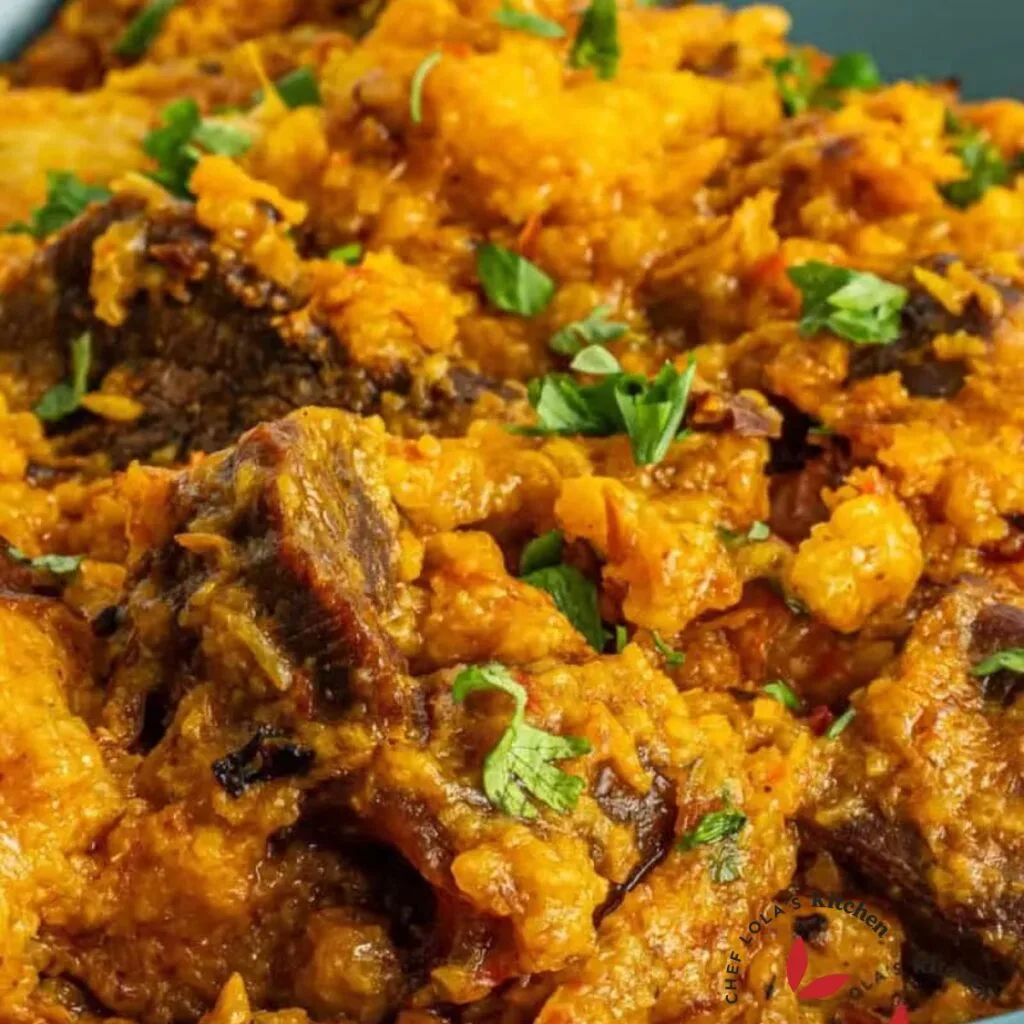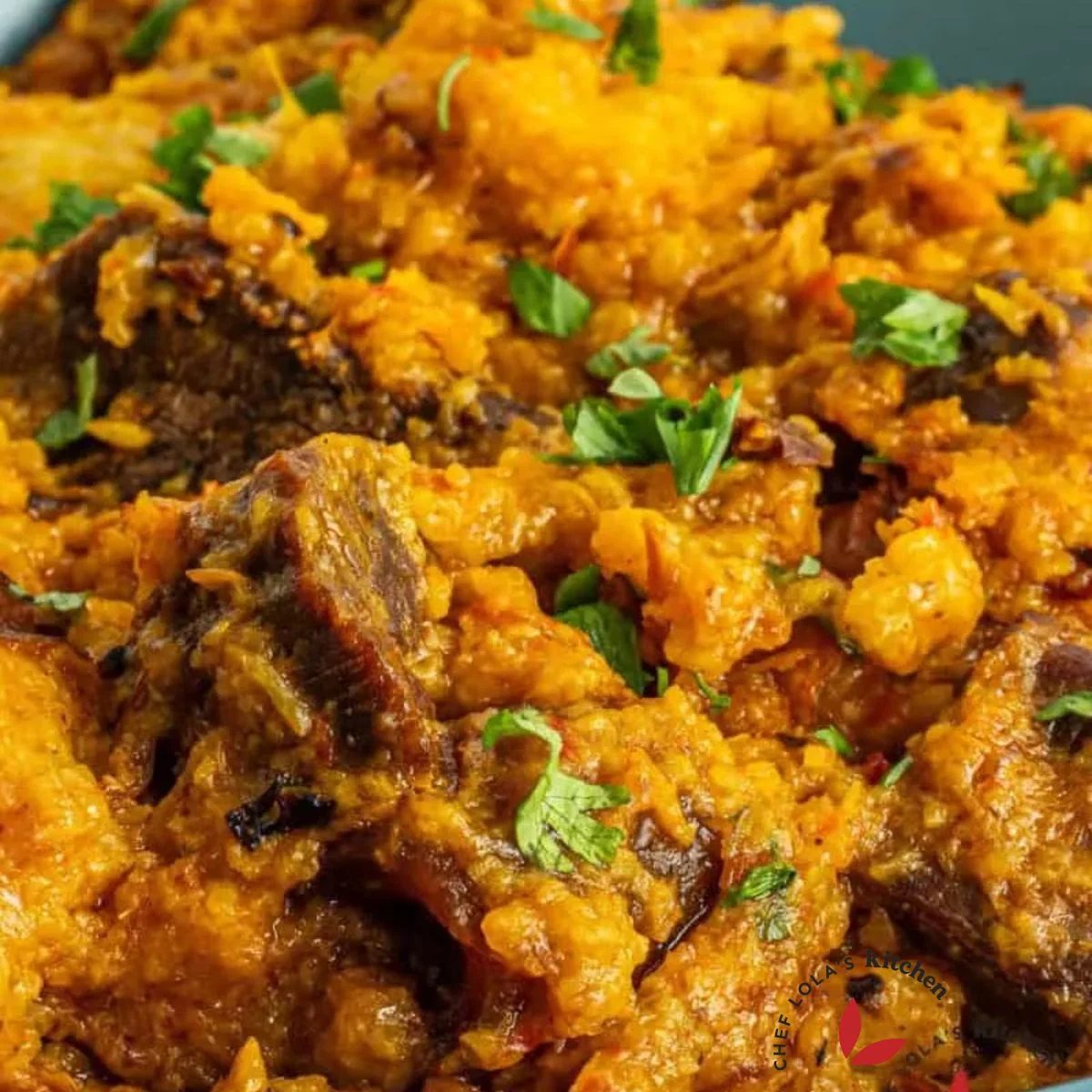Ikokore is a delicious traditional Nigerian dish made from a blend of grated water yam, cooked with proteins and assorted vegetables in a savory, spicy broth.

What is Ikokore/Ifokore?
Ikokore (also known as Ifokore) is a traditional Nigerian dish from the Yoruba people. It is a delicious dish that captures the true essence of Nigerian cuisine. This dish is savory and slightly spicy, with a blend of meaty, fishy, and earthy notes. It may sound weird, but do you know that you can serve ikokore with rice or enjoy it alone.
When Ikokore is mentioned, the first thing that comes to mind is the Ijebu people of Ogun State, Nigeria. This rich, hearty meal is made from water yam (Dioscorea alata), grated to create a base.
Some people have said ikokore is Asaro (yam Porridge) with a twist. Is this true? We will decide that at the end of this article.
Ikokore boasts of bold flavors and a hearty texture. It is thick and starchy, similar to porridge. Traditionally, we make Ikokore with fish and meat, but there are different modern versions nowadays. Aside from fish and meat, the modern version uses vegetables and other proteins like chicken.
Originally, Ijebu people cook ikokore over an open fire in earthen pots. The preparation involves slow cooking to blend flavors and achieve the desired texture. We can all make Ikokore in our kitchen, but traditionally, it's served during celebrations and special events like festivals, weddings, and other significant gatherings.

Ingredients of making Ikokore
- Beef and Cow skin (ponmo): I cut my beef and ponmo into cubes; they add to the richness of the dish. If you don't want beef, you can also use goat meat or offals (such as shaki, tripe, and liver).
- Pound water yam: Grated to form the paste-like texture that forms the porridge-like base of ikokore.
- Pepper mix: A blend of scotch bonnet peppers (ata rodo) and bell peppers adds heat, color, and a fresh, tangy flavor to the dish.
- Crayfish: Dried and ground crayfish adds a robust, seafood-like flavor that enhances the overall taste of the dish.
- Dried fish and grilled Mackerel Fish: I don't joke with my stockfish (panla), dried catfish (arin), or smoked mackerel. The fish gives a smoky, savory flavor to the dish.
- Locust bean: gives a distinct, earthy aroma that complements the other ingredients like fish and meat.
- Palm oil: Adds a rich, earthy flavor and vibrant color to the dish. It also enhances the dish’s depth and traditional taste.
- Bouillon powder: for additional flavor.
- Salt to taste: for taste.
- Parsley: for garnish (Optional)
A Little bit about the Star Ingredient - Water Yam
Yams are versatile starchy tubers cooked by boiling, frying, pounding, or serving as an ingredient in other dishes. This is different from other starchy tubers like potatoes, cocoyam, etc. Yams typically have rough, scaly skin and can be cylindrical or irregular in shape. Depending on the species and growing conditions, they range from small to very large. Different foods from yam include pounded yam, fried yam and yam porridge with plantains.
Water Yam, used for ikokore, is a species of yam known as isu ewura in Yoruba. It has a starchy, slightly slimy texture when grated. To make ikokore, you peel it and grate into a smooth, almost paste-like consistency, providing a thick base for the dish.
How to Make Ikokore
- First, season the beef and cow skin (pomo) with salt and 2 teaspoons of bouillon powder. Mix well, cover, and let them cook in their own juices.
- While the meat is cooking, peel, rinse, and grate the water yam using the smallest holes on your grater. Alternatively, for a quicker method, use a food processor to blend it. Season the grated yam with a bit of salt and 1 teaspoon bouillon powder, then mix well.
- Next, create a rich broth by adding water, dried fish, grilled mackerel, dried prawns, locust beans, blended pepper, ground crayfish, and a splash of palm oil to the boiling meat. Simmer it all together until the meat becomes tender.
- Once the meat is tender, remove all the pieces of meat and other proteins from the pot. Add more water if needed.
- Form small balls from the seasoned water yam mixture with your fingers and gently drop them into the broth. Cover and let these simmer for about 5 to 8 minutes.
- Put the proteins back into the pot, along with a little more palm oil. Simmer everything together for another 3 to 5 minutes. Stir occasionally and break the lumps if desired.
- Taste and adjust the seasonings if necessary.
- Optionally, garnish with chopped parsley for a fresh finish.
- Serve as is or with your desired accompaniment.

Frequently Asked Questions
- How can I adjust the spice level in Ikokore?
You can adjust the spice level by reducing the amount of scotch bonnet peppers in the pepper mix. To make it less spicy, use milder peppers or reduce the quantity.
- Can I use other types of meat or fish in Ikokore?
Of course, you can use different types of meat (chicken, turkey) or fish (fresh fish, smoked fish. The protein you use may change the taste of the food a bit.
- Is Ikokore gluten-free?
Yes, Ikokore is naturally gluten-free. It is made from water yam and does not contain wheat or gluten-containing ingredients.
- Can I make Ikokore vegetarian or vegan?
To make a vegan version, don't use meat and fish. Instead, you can use more vegetables. Also, substitute crayfish with dried mushrooms. Lastly, ensure all seasonings and locust beans are vegan-friendly.
- What makes Ikokore different from Asaro (Yam Porridge)?
Don't mistake ikokore for asaro (yam Pottage). Ifokore is made from grated water yam. On the other hand, asaro is made from chunks of regular yam cooked in a similar base, resulting in a chunkier texture.
How to Store and Reheat Ikokore
Let it cool. Store the leftovers in an airtight container in the refrigerator for up to 3-4 days. Warm gently on the stovetop or microwave, adding a little water if needed. You can also freeze your ikokore for up to a month.
How to Serve Ikokore
Serve your ikokore immediately after cooking or reheating. You can serve Ifokore as follows:
- Serve standalone: Serve Ikokore as the main dish in a bowl. It's a complete meal on its own. You can also garnish with a sprinkle of chopped fresh herbs like scent leaves (Efirin) or parsley for a fresh, aromatic touch.
- Serve as a side dish with plain white or brown rice. For a soft texture contrast, serve with Eko (fermented corn pudding) or Agidi, a smooth, firm pudding made from corn.
- Serve with accompaniments like fried or boiled plantains for a touch of sweetness.
- You can add a side of steamed or sautéed vegetables like spinach or kale to enhance nutritional value and add color.
- Pair with drinks like Zobo (hibiscus tea) or Kunu (a local grain-based drink).
Other Delicious Nigerian Recipes
- Pounded yam
- Yam Porridge (Asaro)
- Fried Yam
- Amala
- African Yam – Fried Puna Yam
- Yam Porridge with plantains

Ikokore/Ifokore - Water Yam Pottage
Ingredients
- 1 pound beef cut into cubes
- ½ pound cow skin Ponmo, cut into cubes
- 2½ pound yam water yam
- 1 cup peppers blended mix of bell peppers and 1-2 rodo
- 1 cup crayfish large
- 2 fish dried
- 1 mackerel fish grilled
- 2 tablespoon crayfish ground
- 2 tablespoon locust beans
- 6 tablespoon palm oil
- 3 teaspoons bouillon powder divided
- salt to taste
- Parsley for garnish, Optional
Instructions
- First, season the beef and cow skin (pomo) with salt and 2 teaspoons bouillon powder. Mix well, cover, and let them cook in their own juices.
- While the meat is cooking, peel, rinse, and grate the water yam using the smallest holes on your grater. Alternatively, for a quicker method, use a food processor to blend it. Season the grated yam with a bit of salt and 1 teaspoon bouillon powder, then mix well.
- Next, create a rich broth by adding water, dried fish, grilled mackerel, dried prawns, locust beans, blended pepper, ground crayfish, and a splash of palm oil to the boiling meat. Simmer it all together until the meat becomes tender.
- Once the meat is tender, remove all the pieces of meat and other proteins from the pot. Add more water if needed.
- Form small balls from the seasoned water yam mixture with your fingers and gently drop them into the broth. Cover and let these simmer for about 5 to 8 minutes.
- Put the proteins back into the pot, along with a little more palm oil. Simmer everything together for another 3 to 5 minutes. Stir occasionally and break the lumps if desired.
- Taste and adjust the seasonings if necessary.
- Optionally, garnish with chopped parsley for a fresh finish.
- Serve as is or with your desired accompaniment.
Nutrition
Let’s make our friendship official on YouTube, Facebook, and Instagram. Don’t forget to give me a shout-out with your dish snaps using @cheflolaskitchen on Instagram and Facebook. Can’t wait to see what you’re cooking up! 🍲🥘🌟
